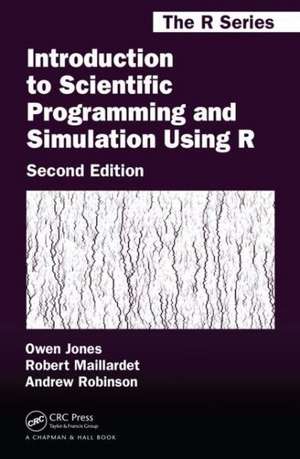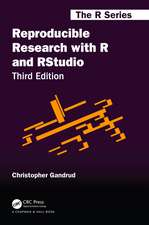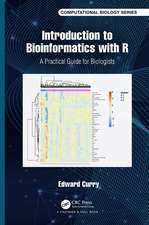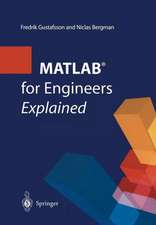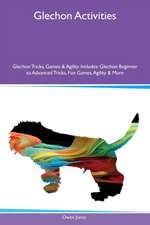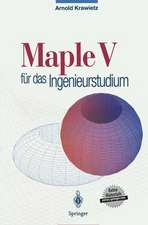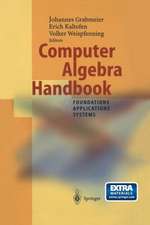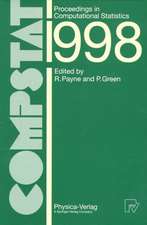Introduction to Scientific Programming and Simulation Using R: Chapman &Hall/CRC The R Series
Autor Owen Jones, Robert Maillardet, Andrew Robinsonen Limba Engleză Hardback – 12 iun 2014
Highly recommended, the best-selling first edition of Introduction to Scientific Programming and Simulation Using R was lauded as an excellent, easy-to-read introduction with extensive examples and exercises. This second edition continues to introduce scientific programming and stochastic modelling in a clear, practical, and thorough way. Readers learn programming by experimenting with the provided R code and data.
The book’s four parts teach:
- Core knowledge of R and programming concepts
- How to think about mathematics from a numerical point of view, including the application of these concepts to root finding, numerical integration, and optimisation
- Essentials of probability, random variables, and expectation required to understand simulation
- Stochastic modelling and simulation, including random number generation and Monte Carlo integration
Another new chapter focuses on both discrete- and continuous-time Markov chains. It describes transition and rate matrices, classification of states, limiting behaviour, Kolmogorov forward and backward equations, finite absorbing chains, and expected hitting times. It also presents methods for simulating discrete- and continuous-time chains as well as techniques for defining the state space, including lumping states and supplementary variables.
Building readers’ statistical intuition, Introduction to Scientific Programming and Simulation Using R, Second Edition shows how to turn algorithms into code. It is designed for those who want to make tools, not just use them. The code and data are available for download from CRAN.
Din seria Chapman &Hall/CRC The R Series
-
 Preț: 350.96 lei
Preț: 350.96 lei - 20%
 Preț: 424.82 lei
Preț: 424.82 lei -
 Preț: 343.32 lei
Preț: 343.32 lei -
 Preț: 358.30 lei
Preț: 358.30 lei - 20%
 Preț: 548.69 lei
Preț: 548.69 lei - 8%
 Preț: 490.79 lei
Preț: 490.79 lei - 23%
 Preț: 1327.47 lei
Preț: 1327.47 lei - 8%
 Preț: 452.19 lei
Preț: 452.19 lei -
 Preț: 400.98 lei
Preț: 400.98 lei - 8%
 Preț: 386.32 lei
Preț: 386.32 lei -
 Preț: 389.17 lei
Preț: 389.17 lei -
 Preț: 391.57 lei
Preț: 391.57 lei -
 Preț: 152.12 lei
Preț: 152.12 lei - 8%
 Preț: 512.40 lei
Preț: 512.40 lei - 20%
 Preț: 421.05 lei
Preț: 421.05 lei -
 Preț: 356.63 lei
Preț: 356.63 lei - 8%
 Preț: 418.06 lei
Preț: 418.06 lei -
 Preț: 373.05 lei
Preț: 373.05 lei - 8%
 Preț: 544.64 lei
Preț: 544.64 lei -
 Preț: 359.66 lei
Preț: 359.66 lei - 8%
 Preț: 437.61 lei
Preț: 437.61 lei -
 Preț: 358.22 lei
Preț: 358.22 lei -
 Preț: 260.53 lei
Preț: 260.53 lei - 8%
 Preț: 422.96 lei
Preț: 422.96 lei - 8%
 Preț: 438.87 lei
Preț: 438.87 lei -
 Preț: 356.63 lei
Preț: 356.63 lei - 20%
 Preț: 308.68 lei
Preț: 308.68 lei -
 Preț: 230.57 lei
Preț: 230.57 lei - 17%
 Preț: 271.58 lei
Preț: 271.58 lei - 15%
 Preț: 494.20 lei
Preț: 494.20 lei -
 Preț: 392.33 lei
Preț: 392.33 lei - 9%
 Preț: 835.78 lei
Preț: 835.78 lei - 20%
 Preț: 1329.88 lei
Preț: 1329.88 lei - 22%
 Preț: 447.69 lei
Preț: 447.69 lei - 24%
 Preț: 566.03 lei
Preț: 566.03 lei - 35%
 Preț: 842.05 lei
Preț: 842.05 lei - 18%
 Preț: 1082.45 lei
Preț: 1082.45 lei - 20%
 Preț: 578.11 lei
Preț: 578.11 lei - 26%
 Preț: 1014.74 lei
Preț: 1014.74 lei - 20%
 Preț: 1066.99 lei
Preț: 1066.99 lei - 27%
 Preț: 527.72 lei
Preț: 527.72 lei
Preț: 542.93 lei
Preț vechi: 678.67 lei
-20% Nou
Puncte Express: 814
Preț estimativ în valută:
103.89€ • 108.76$ • 85.96£
103.89€ • 108.76$ • 85.96£
Carte disponibilă
Livrare economică 15-29 martie
Livrare express 04-08 martie pentru 47.13 lei
Preluare comenzi: 021 569.72.76
Specificații
ISBN-13: 9781466569997
ISBN-10: 1466569999
Pagini: 606
Ilustrații: 133 black & white illustrations, 5 black & white tables
Dimensiuni: 156 x 234 x 33 mm
Greutate: 1 kg
Ediția:2 Rev ed.
Editura: CRC Press
Colecția Chapman and Hall/CRC
Seria Chapman &Hall/CRC The R Series
ISBN-10: 1466569999
Pagini: 606
Ilustrații: 133 black & white illustrations, 5 black & white tables
Dimensiuni: 156 x 234 x 33 mm
Greutate: 1 kg
Ediția:2 Rev ed.
Editura: CRC Press
Colecția Chapman and Hall/CRC
Seria Chapman &Hall/CRC The R Series
Cuprins
Programming. Numerical Techniques. Probability and Statistics. Simulation. Glossary of R Commands. Programs and Functions Developed in the Text. Index.
Recenzii
"The Introduction to Scientific Programming and Simulation Using R (2nd Edition) is a useful and well organized book. The writing is orderly, logical, consistent, intriguing, and engaging. We have read many programming and simulation oriented books that vary in context, scope, and difficulty level. This one turned out to be one of our favorites. It stands out in the sense that a decent dose of theory is given in addition to the programming related aspects. It covers an immense amount of material, yet manages to do so both thoroughly and clearly."
~Hakan Demirtas, Rachel Nordgren, University of Illinois at Chicago
"Computation has become so central to the field of statistics that any practicing statistician must have a basic understanding of scientific programming and stochastic modeling. Introduction to Scientific Programming and Simulation Using R provides an excellent entry-level text on the subject. This is a well written and well-designed book that will appeal to a wide readership and prove useful for several different types of courses. It provides a very good introduction to programming using the R language that has become widely used in statistical education and practice. It also introduces the fundamental tools needed for stochastic modeling: numerical analysis, probability, and simulation.
~Christopher H. Schmid, Journal of the American Statistical Association
Praise for the First Edition:
"Overall, the authors have produced a highly readable text. As prerequisites do not go beyond first-year calculus, the book should appeal to a wide audience; it should also be eminently suitable for self-study. On a somewhat larger scale, it may help to further establish R as a kind of Swiss Army knife for computational science. I strongly recommend it."
~C. Kleiber, Universität Basel, Basel, Switzerland, in Statistical Papers, March 2012
"This book is a good resource for someone who wants to learn R and use R for statistical computing and graphics. It will also serve well as a textbook or a reference book for students in a course related to computational statistics."
~Hon Keung Tony Ng, Technometrics, May 2011
"… a very coherent and useful account of its chosen subject matter. … The programming section … is more comprehensive than Braun & Murdoch (2007), but more accessible than Venables & Ripley (2000). … The book deserves a place on university library shelves … One very useful feature of the book is that nearly every chapter has a set of exercises. There are also plenty of well-chosen examples throughout the book that are used to explain the material. I also appreciated the clear and attractive programming style of the R code presented in the book. I found very little in the way of typos or solecisms. … I can strongly recommend the book for its intended audience. If I ever again have to teach our stochastic modelling course, I will undoubtedly use some of the exercises and examples from Scientific Programming and Simulation Using R."
~David Scott, Australian & New Zealand Journal of Statistics, 2011
"It is not often that I think that a statistics text is one that most scientifc statisticians should have in their personal libraries. Introduction to Scientific Programming and Simulation Using R is such a text. … This text provides scientific researchers with a working knowledge of R for both reviewing and for engaging in the statistical evaluation of scientific data. …It is particularly useful for understanding and developing modeling and simulation software. I highly recommend the text, finding it to be one of the most useful books I have read on the subject."
—Journal of Statistical Software, September 2010, Volume 36
"The authors have written an excellent introduction to scientific programming with R. Their clear prose, logical structure, well-documented code and realistic examples made the book a pleasure to read. One particularly useful feature is the chapter of cases studies at the end, which not only demonstrates complete analyses but also acts as a pedagogical tool to review and integrate material introduced throughout the book. … I would strongly recommend this book for readers interested in using R for simulations, particularly for those new to scientific programming or R. It is also very student-friendly and would be suitable either as a course textbook or for self-study."
—Significance, September 2009
"I think that the techniques of scientific programming presented will soon enable the novice to apply statistical models to real-world problems. The writing style is easy to read and the book is suitable for private study. If you have never read a book on scientific programming and simulation, then I recommend that you start with this one."
—International Statistical Review, 2009
~Hakan Demirtas, Rachel Nordgren, University of Illinois at Chicago
"Computation has become so central to the field of statistics that any practicing statistician must have a basic understanding of scientific programming and stochastic modeling. Introduction to Scientific Programming and Simulation Using R provides an excellent entry-level text on the subject. This is a well written and well-designed book that will appeal to a wide readership and prove useful for several different types of courses. It provides a very good introduction to programming using the R language that has become widely used in statistical education and practice. It also introduces the fundamental tools needed for stochastic modeling: numerical analysis, probability, and simulation.
~Christopher H. Schmid, Journal of the American Statistical Association
Praise for the First Edition:
"Overall, the authors have produced a highly readable text. As prerequisites do not go beyond first-year calculus, the book should appeal to a wide audience; it should also be eminently suitable for self-study. On a somewhat larger scale, it may help to further establish R as a kind of Swiss Army knife for computational science. I strongly recommend it."
~C. Kleiber, Universität Basel, Basel, Switzerland, in Statistical Papers, March 2012
"This book is a good resource for someone who wants to learn R and use R for statistical computing and graphics. It will also serve well as a textbook or a reference book for students in a course related to computational statistics."
~Hon Keung Tony Ng, Technometrics, May 2011
"… a very coherent and useful account of its chosen subject matter. … The programming section … is more comprehensive than Braun & Murdoch (2007), but more accessible than Venables & Ripley (2000). … The book deserves a place on university library shelves … One very useful feature of the book is that nearly every chapter has a set of exercises. There are also plenty of well-chosen examples throughout the book that are used to explain the material. I also appreciated the clear and attractive programming style of the R code presented in the book. I found very little in the way of typos or solecisms. … I can strongly recommend the book for its intended audience. If I ever again have to teach our stochastic modelling course, I will undoubtedly use some of the exercises and examples from Scientific Programming and Simulation Using R."
~David Scott, Australian & New Zealand Journal of Statistics, 2011
"It is not often that I think that a statistics text is one that most scientifc statisticians should have in their personal libraries. Introduction to Scientific Programming and Simulation Using R is such a text. … This text provides scientific researchers with a working knowledge of R for both reviewing and for engaging in the statistical evaluation of scientific data. …It is particularly useful for understanding and developing modeling and simulation software. I highly recommend the text, finding it to be one of the most useful books I have read on the subject."
—Journal of Statistical Software, September 2010, Volume 36
"The authors have written an excellent introduction to scientific programming with R. Their clear prose, logical structure, well-documented code and realistic examples made the book a pleasure to read. One particularly useful feature is the chapter of cases studies at the end, which not only demonstrates complete analyses but also acts as a pedagogical tool to review and integrate material introduced throughout the book. … I would strongly recommend this book for readers interested in using R for simulations, particularly for those new to scientific programming or R. It is also very student-friendly and would be suitable either as a course textbook or for self-study."
—Significance, September 2009
"I think that the techniques of scientific programming presented will soon enable the novice to apply statistical models to real-world problems. The writing style is easy to read and the book is suitable for private study. If you have never read a book on scientific programming and simulation, then I recommend that you start with this one."
—International Statistical Review, 2009
Notă biografică
Owen Jones, Robert Maillardet, Andrew Robinson
Descriere
With new chapters on ODEs and Markov chains, the second edition of this highly recommended, best-selling book introduces scientific programming and stochastic modelling in a clear, practical, and thorough way. Readers learn programming by experimenting with the provided R code and data. Requiring no prior knowledge of programming or probability, the book shows them how to turn algorithms into code. It includes case studies that demonstrate the simulation techniques as well as numerous student projects and exercises.
